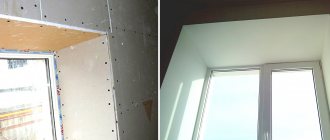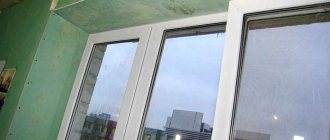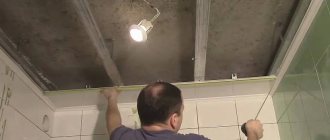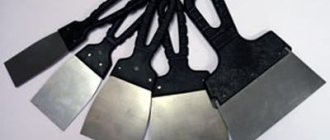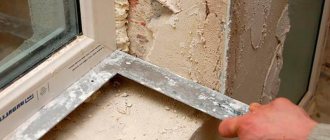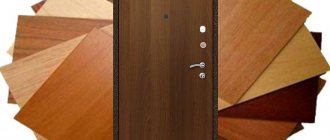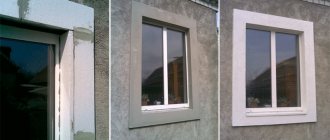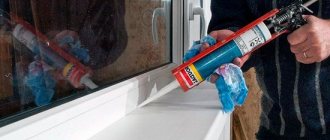Item Description
This type of fittings refers to decorative accompanying elements when finishing plastic slopes. As noted earlier, a window corner for a slope can be used to mask corner joints when working with various materials.
The corner is used to mask the junction of the slope and the wall
The decorative plastic corner is made using special technologies, when a rigid PVC sheet is bent using a “hot” method.
Kinds
The product is universal and is widely used for finishing corners and joints of surfaces made of various finishing materials. Types of plastic corners differ in the material of manufacture and can be made in three versions .
| Made of metal | |
| Made of wood | |
| Made of plastic |
Plastic elements for finishing the slopes of plastic windows have become most popular among consumers. Colored elements can be matched to any interior color scheme. The laminated surface can imitate various materials.
Where is it used?
Plastic angle corners for slopes are widely used for various types of work. It can perform a decorative and practical function at the same time.
- colored elements decorate the corners of window and door openings;
Decorative decoration of a window opening - To install a plasterboard structure, you will need metal elements to fix the corners. Guide metal corners are used when constructing slopes made of plaster. The positive quality of this method is that the guides are not removed, but remain in the body of the structure, ensuring its strength;
Using metal corners, plasterboard slopes are fixed - when wallpapering walls, pasted corners for slopes will protect the corners of the walls from damage;
Corner protects the wall corner from damage - installation of corner strips is carried out for finishing joints when working with various materials. The elements can be used for external slopes.
External joints are also covered with corners
What is the angle of dawn?
Finishing is carried out with a wide range of sheet-type materials or using plaster. A stage of work that cannot be omitted when forming a window opening is the angle of dawn. This angle is considered to be the distance from the outer to the inner bevel strip. This characteristic is responsible for the penetration of natural light, so it should have the same value for all windows. This value is always greater than 90° to visually make the room brighter.
measure the angle of dawn using a square. A bar is attached to it, measuring the position of the rule. When the rule is established and checked by level, the next step is to secure and cladding the window block. Thus, for each side, a rule will be needed so that the corner dawn is set along the perimeter of the window.
Classification
Plastic elements vary depending on the purpose and type of finishing work.
| Name | Appearance |
| Equilateral. They are used when finishing window slopes. | |
| Versatile. Most often they are used to decorate arches. | |
| T-shaped. Used for window slopes when it is necessary to mask the joint between them and the wall. | |
| f-shaped. Used for finishing joints and for reliable fixation of plastic plates in grooves. The starting profile provides a decorative appearance to the end and levels the overall plane. f - shaped profile is used for finishing the window opening. | |
| Removable. They have a latch, which facilitates repair work that does not require removing the slope profile. |
Depending on the type of work performed, installation of corners can be external or internal.
Prefabricated slopes
This method of facing an opening will be more expensive than using plaster. But sheet materials or so-called prefabricated slopes have their advantages:
- Sheet materials are quite easy to work with;
- Installation of sheets is carried out dry;
- The material has a smooth surface and does not require leveling;
- Finishing generally takes less time.
Dimensions
Dimensions are selected based on the type of work to be done - indoors or outdoors . The condition of the corner is also assessed for the presence and nature of defects and damage.
To finish external slopes use wide corners
When installing corners on slopes, it will be enough to use elements measuring 10 x 10 mm or 20 x 20 mm. Wider elements are used for exterior window decoration.
How to form a dawn angle?
In order for the slopes to last a long time after the work is completed, it is necessary to use high-quality cement . To prepare it, you should take one share of cement to three shares of well-washed river sand. You should not reduce these proportions, otherwise the finishing surface will crack over time. To make the composition acceptable for work, you can add alabaster. But this only applies to internal work.
Often, difficulties arise at the stage of plastering uneven areas on the upper part. To make the work easier, plastering is done in two stages. The second is started only when the first layer of plaster has completely dried. To remove irregularities as completely as possible, a reinforcing mesh is used, and the second layer is placed on top of it.
The next step, according to the previously measured angle of dawn, is to apply the strip to the wall so that the plate slides freely along it. Then you need to hang the rule, securing it with nails. Plastering work should begin from the top. When the top part is plastered, the rules are hung vertically on the sides and only then they are plastered. While the solution has not hardened, it must be leveled using a wide spatula according to the established rule.
When the top slope is completed, repeat the process on the side slopes, adhering to the measured dawn angle. For indoor cladding, mixtures of cement, lime and cement, gypsum with polymers are used. When forming a slope, it is convenient to use gypsum mixtures, but it is better not to use them in large quantities.
Peculiarities
These elements have become widespread in various fields due to their positive qualities.
- used to mask corner joints of various materials; right angles are formed at the finishing site;
- These are durable elements, the service life of which is estimated at tens of years; they are easy to install and process;
- the presence of several types of materials from which these products are made allows them to be used in different conditions and for different jobs; a wide range of colors and textures for the appearance of fittings; they are affordable;
- like the PVC profile for slopes, the fittings are highly moisture resistant;
- despite the fact that plastic slopes are susceptible to the formation of condensation on their surface, neither they nor the corners rot or become moldy;
- installation of plastic elements on slopes made of plaster allows you to form perfectly even corners;
- during repair work, metal perforated products are used to strengthen joints and corners;
- PVC profiles and corners are safe for the environment and people;
- due to the low weight of the PVC profile and corner, the structure is not loaded;
- they are resistant to mechanical stress and are not subject to deformation under the influence of the sun.
Disadvantages include the fragility of the material, which is easily damaged during processing, and the release of toxic substances during a fire.
Glue selection
When choosing an adhesive composition, it is necessary to give preference to such products that can be used for PVC products.
It is common to use silicone sealants for gluing a product, but it is important to consider that they are washed off with water and lose their qualities over time. As a result, the product may become loose .
Installation of slopes on plastic windows and their finishing has recently been increasingly carried out using “liquid plastic” technology.
Liquid plastic is used to glue slopes using new technology
For this purpose, glue of the same name is used, which is a liquid plastic. This material has many positive qualities:
- it does not lose its performance even after ten years;
- it does not turn yellow over time like silicone sealant;
- allows you to create an integral monolithic structure when finishing a window opening.
It is not recommended to use silicone sealant for gluing slopes.
You can use it to glue the starting profile. Liquid plastic is used as window sill adhesive. This modern material is also used for installing plastic trim on windows.
Preparation and installation
To learn how to glue plastic corners, you can familiarize yourself with the sequence of work.
First you need to make sure that the corners do not have obvious protruding elements. Before gluing the product, it must be degreased.
How to glue plastic corners to slopes efficiently and reliably is described below.
- The product is applied to the surface of the wall and the necessary marks are made from below and above on the elements that will be located vertically and on both sides of the horizontal elements of the window slopes;
Measuring corners - To avoid the appearance of a gap, the measurement of vertical parts should take place after attaching the upper horizontal corner, and the lower ones - after gluing the elements vertically;
- Using metal scissors, you need to make cuts in accordance with the marks. In this case, the inner part is cut at a right angle, and the outer part is cut at 45°;
The outer part of the corner is cut at an angle of 45° - To properly glue products to window slopes, apply an adhesive composition to the inside of the product, maintaining an interval of 1 - 1.5 cm.
Applying glue to the corner - The products should be fastened by pressing them firmly to the corners of the window slopes. To achieve a strong adhesion, the products should be secured with masking tape. . When working with liquid PVA, the strength of the connection is ensured after 1 minute.
It is recommended to fix the corner after gluing with masking tape.
Types of protective corners: from what materials
Before you understand how to glue a corner to a wall with wallpaper, you should understand the existing types. In this article, the emphasis is on working inside the house, highlighting the following types of corners:
- Plastic, created in different shades and textures;
- Metal;
- Made of wood, it can create relief on the surface;
- MDF, creates the effect of different wood, there may be patterns, the structure is smooth;
- Cork;
- Made from rubber, they are popularly used in medical and children's institutions;
- Foamed type of rubber, soft option, convenient for children's rooms;
- Decorative, they are complemented with various details - rhinestones, stones, etc.
Most often, plastic products are chosen; there are many options on sale. If you look for something, you can choose the best option in terms of shade and texture so that they look beautiful and stylish in the room.
Plastic, they are created in different shades and textures.

